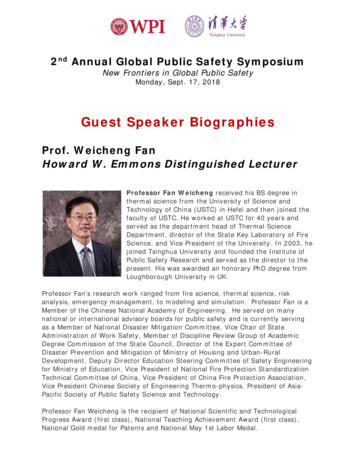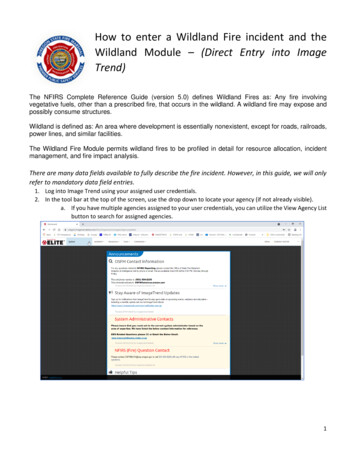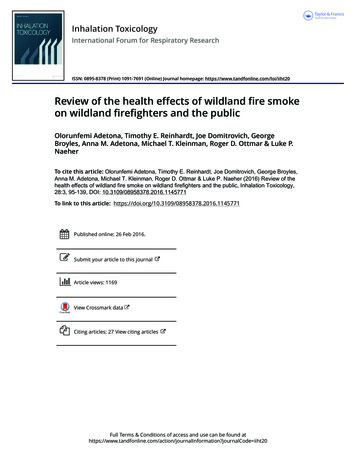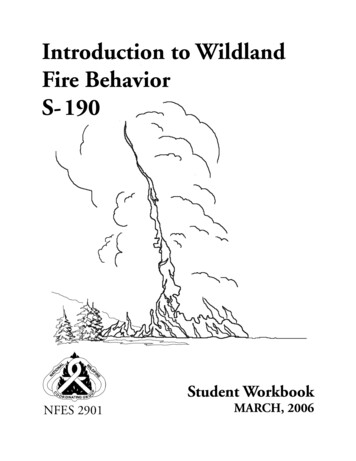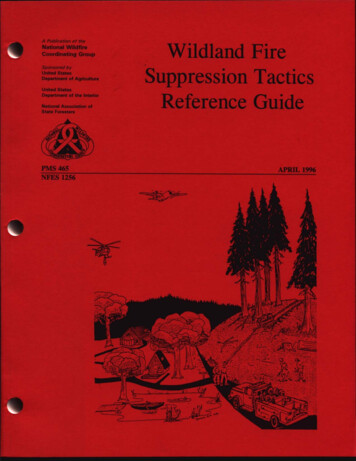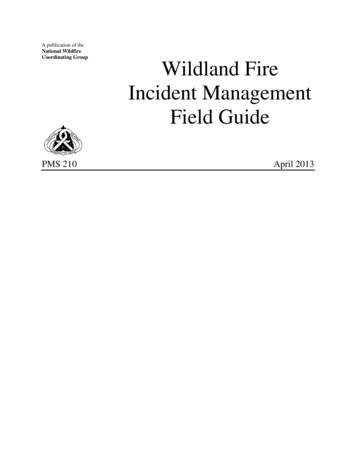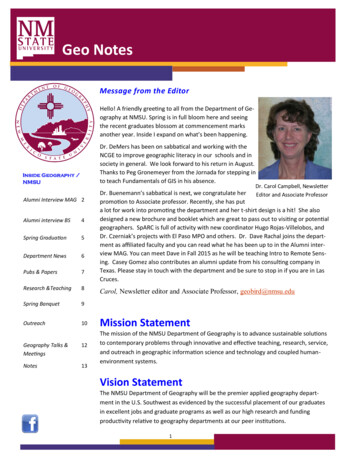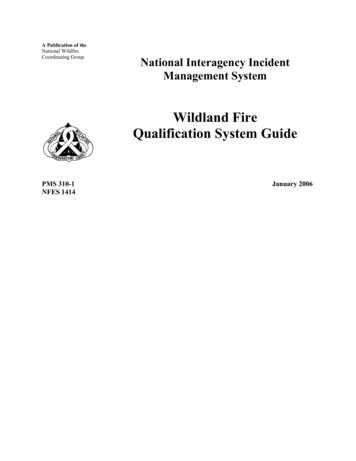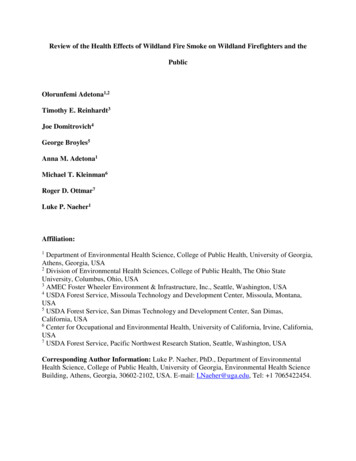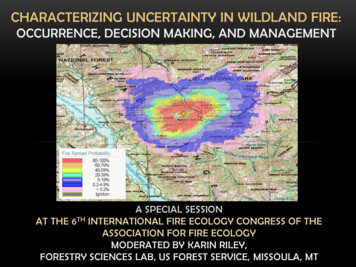
Transcription
CHARACTERIZING UNCERTAINTY IN WILDLAND FIRE:OCCURRENCE, DECISION MAKING, AND MANAGEMENTA SPECIAL SESSIONAT THE 6 TH INTERNATIONAL FIRE ECOLOGY CONGRESS OF THEASSOCIATION FOR FIRE ECOLOGYMODERATED BY KARIN RILEY,FORESTRY SCIENCES LAB, US FOREST SERVICE, MISSOULA, MT
UNCERTAINTY ANALYSIS OFWILDFIRE MODELINGBurn ProbabilityKarin Riley and Matt ThompsonForestry Sciences Lab, US Forest Service, Missoula, Montana6th International Fire Ecology Congress of the Association for Fire EcologyNovember 19, 2015 * San Antonio, Texas
FIRE MODELING IS USED FOR RISK MANAGEMENT, DECISIONSUPPORT, AND LAND MANAGEMENT PLANNING Three planninghorizons: Incident(1-30 days) Mid-term(1-10 years) Long-term(10-50 years)Sheep Fire, Montana, 2015
WHY ANALYZE SOURCES OF UNCERTAINTY? When done: When not done: Model accuracy can beundermined Inappropriate data ormodeling techniques may bechosen Guides model calibrationand validation Increases managers’confidence in results Guides future investments indata collection, research, ormodeling Facilitates communicationof uncertainty
OBJECTIVE Present an uncertainty analysis framework{SystematicRigorousConsistent
A FRAMEWORK FOR UNCERTAINTY ANALYSISWeatherLandscape Based on Ascough II et al. [2008], Warmink et al. [2010], and Skinner etal. [2014], but tailored to the wildfire modeling context
A FRAMEWORK FOR UNCERTAINTY ANALYSISAlgorithmic & softwareimplementationLandscapeFire ignition,spread, andintensityFire spread(2D)ClimateWhich processes areinside model?Rate-of-spread andintensity equationsRelationship betweenvariables & systemWind speed anddirection forecastsData for specific runFire behavior fuelmodel loadingparametersValues invariant in model
A FRAMEWORK FOR UNCERTAINTY ANALYSISClimate changeDon’t w probabilityFire behaviorCan’t quantify
UNCERTAINTIES COMMON ACROSSPLANNING HORIZONS:FIRE BEHAVIOR Mechanisms producing firespread not yet known Direct flame contact producedby buoyancy-driveninstabilities likely mechanism,but not yet modeled (Finney etal 2015)
UNCERTAINTIES COMMON ACROSSPLANNING HORIZONS:FIRE BEHAVIOR (AS IMPLEMENTED) Current empirical models offire spread (e.g. Rothermel1972) provide estimates ofspread considered accuratewithin a factor of 2-3
Increasing uncertaintyIncreasing spatial & temporal scaleUNCERTAINTY IN IGNITIONS ACROSSPLANNING HORIZONS
Increasing uncertaintyIncreasing spatial & temporal scaleFACTORS INFLUENCING FIRE OCCURRENCEACROSS PLANNING HORIZONS
UNCERTAINTY MATRIXxxxTemp & RH forecastxxxLandscape Vegetation type &configurationxxxSurface & canopyfuel modelxxxFuel calModelstructureInputWind speed &direction horizonNature
COMPOUNDING UNCERTAINTY
CONCLUSIONS Systematic identification and classification of uncertainty faced inwildfire modeling Some sources of uncertainty are common across incident, mid-term,and long-term planning horizons fire behavior At broader spatial and temporal scales, more sources of uncertaintyappear while others grow in magnitude compoundinguncertainty Are modeling approaches used in one planning horizonappropriate in others?
CONCLUSIONS Positive aspects of identifying and analyzing uncertainty: Can increase confidence in model predictions Can improve the modeling process Can improve study design Can enhance communication across modelers, analysts,decision makers, and stakeholders We present a framework for future analyses
QUESTIONS?ReferencesFinney, Mark A., Jack D. Cohen, Jason M. Forthofer, Sara S. McAllister, Michael J. Gollner, Daniel J. Gorham,Kozo Saito, Nelson K. Akafuah, Brittany A. Adam, and Justin D. English. 2015. Role of buoyant flame dynamicsin wildfire spread. Proceedings of the National Academy of Sciences.Riley, Karin L. and Matthew P. Thompson (In Press), An uncertainty analysis of wildfire modeling. In: Riley,Karin L., Matthew P. Thompson, and Peter Webley (Editors), Natural Hazard Uncertainty Assessment:Modeling and Decision Support. Wiley Books and American Geophysical Union Monographs.Rothermel, R.C. (1972), A mathematical model for predicting fire spread in wildland fuels, USDA Forest ServiceResearch Paper INT-115, USDA Forest Service Intermountain Forest and Range Experiment Station, Ogden,Utah.Skinner, D. J., S. A. Rocks, and S. J. Pollard (2014), A review of uncertainty in environmental risk: characterisingpotential natures, locations and levels, Journal of Risk Research, 782 17(2), 195-219.Warmink, J., J. Janssen, M. J. Booij, and M. S. Krol (2010), Identification and classification of uncertainties in theapplication of environmental models, Environmental Modelling & Software, 25(12), 1518-1527.“UNCERTAINTY IS AN UNCOMFORTABLE POSITION. BUTCERTAINTY IS AN ABSURD ONE.” --VOLTAIRE
CHARACTERIZING UNCERTAINTY IN WILDLAND FIRE: OCCURRENCE, DECISION MAKING, AND MANAGEMENT. . 6th International Fire Ecology Congress of the Association for Fire Ecology November 19, 2015 * San Antonio, Texas Karin Riley and Matt Thompson Forestry Sciences Lab, US Forest Service, Missoula, Montana . Proceedings of the National Academy of .

